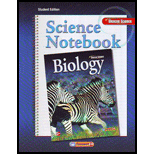
Concept explainers
To summarize:
The role played by anatomy in teaching about evolution by completing the given table.
Introduction: There are many evidences that suggest origin of species from a common ancestor; such as structural adaptations, fossil records, comparative anatomy, embryology, biochemistry, geographical distribution etc. Comparative anatomical studies suggest some species have common ancestor. Evolution predicts that an organism’s body parts are more likely to be modifications of ancestral body parts than they are to be entirely new features.
Answer to Problem 4MI
| Structure | What is it? | Example |
| Homologous structure | Anatomically similar structures inherited from a common ancestor are called homologous structures. | Forelimbs of bats and humans are similar in structure. |
| Analogous structure | Functionally similar but structurally different structures not inherited from a common ancestor are called analogous structures. | Wings of an eagle and wings of a beetle are analogous structures. |
| Vestigial structure | These are structures that are the reduced forms of functional structures in other organisms. | Wings of kiwis |
| Embryo | The early stages of development of plant or animal is called embryo. | Embryos of fish, birds, reptiles, and mammals have homologous structures. |
Explanation of Solution
Anatomically similar structures inherited from a common ancestor are called homologous structures. Bird wings and reptile legs are homologous structures. In some cases such as in kiwis, a functioning structure like wing is smaller or less functional. It cannot be used for flying. Such structures are called vestigial structures. Features of ancestors that no longer have a function for that species will become smaller over time until they are lost. All anatomically similar features are not evidence for common ancestry. Some structures have similar functions but differ in construction. They are not inherited from a common ancestor. These are called analogous structures. Wing of an eagle and wing of a beetle help the species to fly but they have different origins. This suggests that functionally similar structures can evolve independently in similar environments.
Comparative embryology also provides some evidences of evolutionary relationships. Vertebrate embryos show homologous structures during certain phases of development but become different structures in adult forms. Embryois an early stage of development of plant or animal. The shared features in the embryos suggest that vertebrates likefish, birds, reptiles, and mammals have evolved from a shared ancestor.
Chapter 15 Solutions
Biology Science Notebook
Additional Science Textbook Solutions
Human Anatomy & Physiology (11th Edition)
Microbiology with Diseases by Body System (4th Edition)
Campbell Essential Biology with Physiology (5th Edition)
Campbell Biology (10th Edition)
Microbiology with Diseases by Taxonomy (5th Edition)
 Human Anatomy & Physiology (11th Edition)BiologyISBN:9780134580999Author:Elaine N. Marieb, Katja N. HoehnPublisher:PEARSON
Human Anatomy & Physiology (11th Edition)BiologyISBN:9780134580999Author:Elaine N. Marieb, Katja N. HoehnPublisher:PEARSON Biology 2eBiologyISBN:9781947172517Author:Matthew Douglas, Jung Choi, Mary Ann ClarkPublisher:OpenStax
Biology 2eBiologyISBN:9781947172517Author:Matthew Douglas, Jung Choi, Mary Ann ClarkPublisher:OpenStax Anatomy & PhysiologyBiologyISBN:9781259398629Author:McKinley, Michael P., O'loughlin, Valerie Dean, Bidle, Theresa StouterPublisher:Mcgraw Hill Education,
Anatomy & PhysiologyBiologyISBN:9781259398629Author:McKinley, Michael P., O'loughlin, Valerie Dean, Bidle, Theresa StouterPublisher:Mcgraw Hill Education, Molecular Biology of the Cell (Sixth Edition)BiologyISBN:9780815344322Author:Bruce Alberts, Alexander D. Johnson, Julian Lewis, David Morgan, Martin Raff, Keith Roberts, Peter WalterPublisher:W. W. Norton & Company
Molecular Biology of the Cell (Sixth Edition)BiologyISBN:9780815344322Author:Bruce Alberts, Alexander D. Johnson, Julian Lewis, David Morgan, Martin Raff, Keith Roberts, Peter WalterPublisher:W. W. Norton & Company Laboratory Manual For Human Anatomy & PhysiologyBiologyISBN:9781260159363Author:Martin, Terry R., Prentice-craver, CynthiaPublisher:McGraw-Hill Publishing Co.
Laboratory Manual For Human Anatomy & PhysiologyBiologyISBN:9781260159363Author:Martin, Terry R., Prentice-craver, CynthiaPublisher:McGraw-Hill Publishing Co. Inquiry Into Life (16th Edition)BiologyISBN:9781260231700Author:Sylvia S. Mader, Michael WindelspechtPublisher:McGraw Hill Education
Inquiry Into Life (16th Edition)BiologyISBN:9781260231700Author:Sylvia S. Mader, Michael WindelspechtPublisher:McGraw Hill Education





